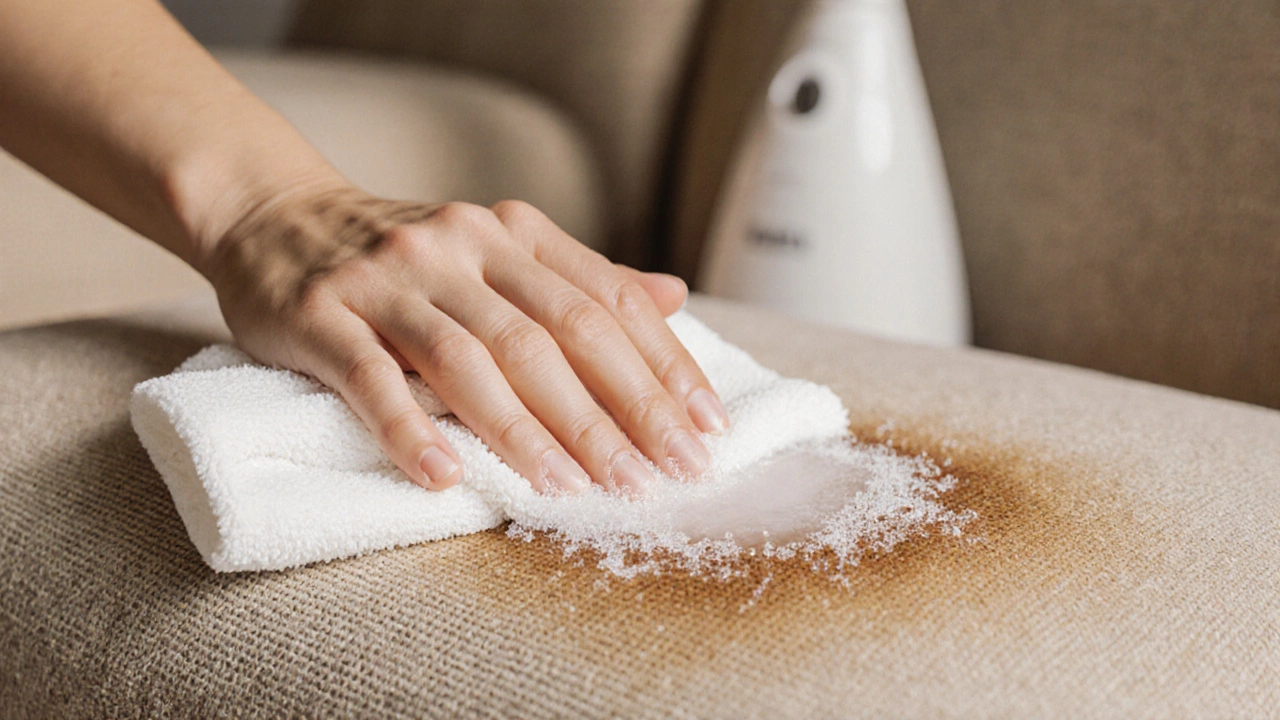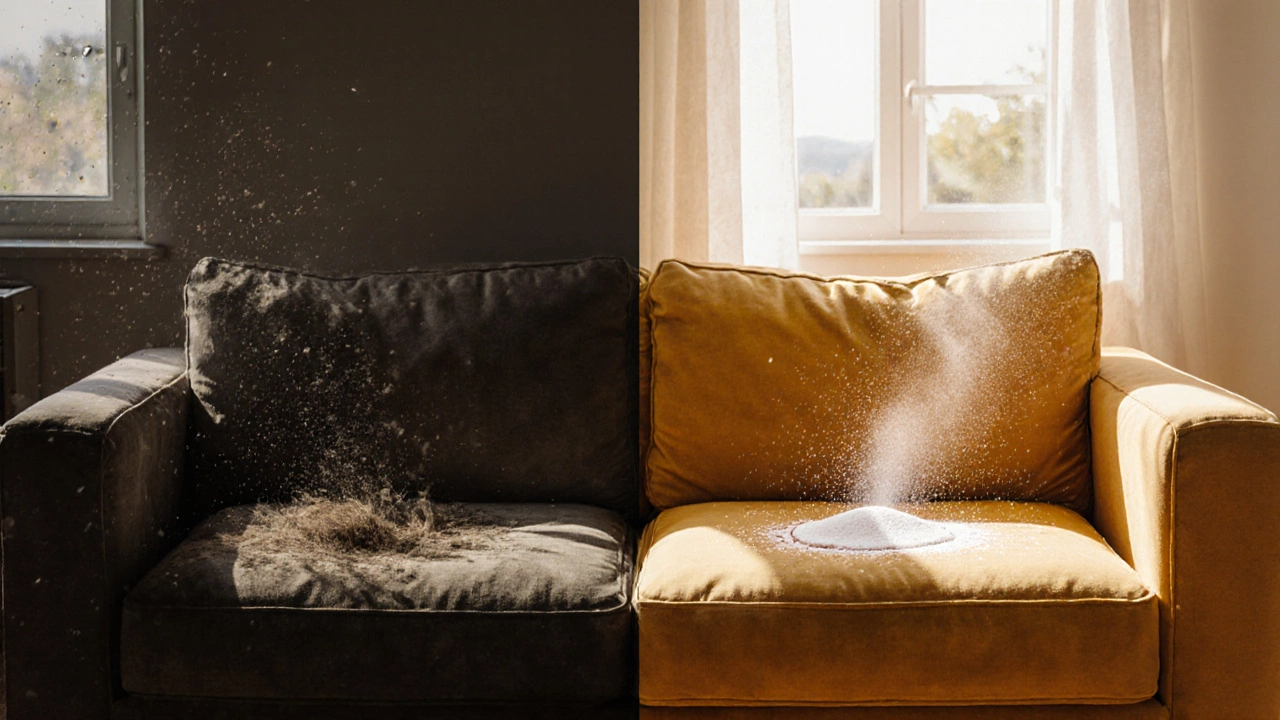Most people don’t realize how much dirt, dust, and bacteria hide in their sofa or armchair. Even if it looks clean, your upholstery is likely holding onto sweat, pet dander, food crumbs, and spilled drinks from years of use. Deep cleaning upholstery isn’t just about looks-it’s about health, smell, and extending the life of your furniture. And the good news? You don’t need to hire a professional or spend hundreds of pounds. With the right tools and a little time, you can do it yourself and get results that last.
What You’ll Need Before You Start
You don’t need fancy gear. Most of what you need is already in your cupboard. Here’s the bare minimum:
- Handheld vacuum with upholstery attachment
- Baking soda
- White vinegar
- Distilled water
- Mild dish soap (like Dawn or Fairy)
- Soft-bristled brush or clean toothbrush
- Clean, white microfiber cloths (no dyes or patterns)
- Steam cleaner (optional, but helpful for deep stains)
- Plastic gloves
Never use a regular vacuum without the upholstery tool-it’ll just push dirt deeper. And always use white cloths. Colored ones can bleed dye onto light fabrics and ruin your sofa.
Step 1: Check the Care Label
Before you touch anything, flip over your cushion or check the side seam for a small fabric code. It’ll say something like W, S, SW, or X.
- W = Water-based cleaner safe
- S = Solvent-based cleaner only (no water)
- SW = Either water or solvent
- X = Vacuum only-no liquids at all
If your sofa says X, skip the vinegar and soap. Stick to vacuuming and dry brushing. If it’s W or SW, you’re good to go with a mild cleaning solution. Ignoring this label is the #1 reason people ruin their upholstery.
Step 2: Vacuum Thoroughly
Think of this like prepping a surface before painting. You’re removing surface dirt so your cleaner can actually reach the stains. Use the upholstery attachment and go slowly. Pay attention to:
- Crevices between cushions
- Under armrests
- Seams and stitching
- Back and sides of the sofa
Hold the nozzle in each spot for 5-10 seconds. You’ll be surprised how much dust and hair comes out. Do this twice if your sofa is old or has pets. This step alone removes up to 70% of surface grime.
Step 3: Treat Stains Immediately
Not all stains are the same. Here’s how to handle the most common ones:
Food, Drink, or Mud Stains
Blot up excess with a dry cloth-don’t rub. Mix 1 tablespoon of mild dish soap with 2 cups of distilled water. Dip a microfiber cloth in the solution, wring it out until it’s barely damp, and dab the stain. Work from the outside in to avoid spreading it. Rinse by dabbing with a cloth dipped in plain water. Blot dry with a clean towel.
Grease or Oil Stains
Sprinkle baking soda directly on the stain. Let it sit for at least 30 minutes (overnight is better). The powder absorbs the oil. Then vacuum it up. If the stain remains, mix 1 part white vinegar with 1 part water. Dab lightly, then blot dry. Vinegar breaks down grease without leaving residue.
Urine or Pet Odors
Blot up as much as you can. Then mix 1 cup of distilled water, 1 cup of white vinegar, and 2 tablespoons of baking soda. Pour it over the area. Let it fizz for 10 minutes, then blot dry. Sprinkle more baking soda on top and leave it overnight. Vacuum it up the next day. This kills odor-causing bacteria, not just masks the smell.

Step 4: Deep Clean with a Steam Cleaner (Optional but Effective)
If you own a steam cleaner, now’s the time to use it. Fill it with distilled water and a drop of mild detergent if your fabric allows it. Run the machine slowly over the entire surface, overlapping each pass by half. Don’t hold it in one spot too long-over-wetting can damage padding or cause mold.
Steam kills 99% of dust mites and bacteria. It also lifts dirt from deep in the fibers. For a standard 3-seater sofa, this takes about 45 minutes. Let it dry completely before sitting on it.
Step 5: Deodorize with Baking Soda
Even after cleaning, upholstery can hold onto smells. Sprinkle a thin, even layer of baking soda over the entire surface. Use a sieve or shaker for control. Let it sit for at least 15 minutes. For strong odors, leave it overnight.
Then vacuum it up with the upholstery tool. You’ll notice the fabric feels fresher and smells cleaner-no artificial sprays needed. This step is cheap, safe, and works better than any commercial air freshener.
Step 6: Dry Properly
Drying is just as important as cleaning. Wet upholstery breeds mold and mildew. Open windows. Turn on a fan. If it’s cold or damp outside, use a dehumidifier. Never use a hairdryer-it can shrink or scorch fabric.
Wait at least 6-8 hours before using the sofa again. If it still feels damp, wait longer. Rushing this step is why some people end up with musty-smelling furniture after a DIY clean.

How Often Should You Deep Clean Upholstery?
Every 6-12 months is ideal for most homes. But if you have kids, pets, or allergies, clean every 3-4 months. High-traffic areas like the center of the sofa or armrests show wear faster. Spot-clean spills right away-don’t wait. That’s the secret to keeping your upholstery looking new for years.
What Not to Do
There are a few mistakes people make over and over:
- Using bleach or ammonia-these destroy fabric dyes and fibers
- Rubbing stains-it grinds dirt deeper into the weave
- Using too much water-soaked padding takes weeks to dry and can rot
- Using colored cloths-dye transfer ruins light fabrics
- Skipping the vacuum-cleaning over dirt just spreads it around
Stick to gentle methods. Upholstery isn’t made to handle harsh chemicals. Your sofa will thank you.
When to Call a Professional
You can handle most stains and odors yourself. But call a pro if:
- The fabric is silk, velvet, or leather (these need special care)
- You have deep, set-in stains that won’t budge
- The sofa is antique or has high-value upholstery
- You’ve tried everything and it still smells musty
Professional steam cleaning costs between £80 and £150 in the UK, depending on size. It’s worth it for delicate or expensive pieces-but for standard fabric sofas, DIY saves you money and works just as well.
Prevent Future Stains
Once your sofa is clean, protect it:
- Use washable throw blankets on high-use areas
- Keep food and drinks away from the sofa
- Brush the fabric weekly with a soft brush to lift dust
- Apply a fabric protector spray (like Scotchgard) every 6 months
These small habits cut cleaning time in half and keep your sofa looking fresh longer.
Deep cleaning upholstery isn’t a chore-it’s an investment. Your sofa is one of the most used pieces of furniture in your home. Treating it right means you won’t need to replace it for another 10-15 years. And that’s a lot more cost-effective than buying new every few years.
Can I use vinegar and baking soda together on my sofa?
Yes, but not at the same time. Use baking soda first to absorb odors and oils, then vacuum it up. After that, use a vinegar-water solution to clean stains. Mixing them directly creates fizzing, but the reaction neutralizes both ingredients, making them less effective. Always apply them separately and let one dry before using the next.
Will deep cleaning shrink my sofa fabric?
Only if you use too much water or heat. Always use distilled water and avoid steam cleaners on delicate fabrics like wool or linen unless the care label says it’s safe. Blot, don’t soak. Let the fabric air dry naturally. Most modern upholstery is designed to handle light moisture, but over-saturation can cause shrinkage or warping.
How do I clean a microfiber sofa?
Microfiber is usually labeled S or SW. Start by vacuuming. For stains, use a dry brush to lift the nap, then dab with a cloth dampened with rubbing alcohol (isopropyl alcohol). Don’t use water-based cleaners unless the label allows it. After cleaning, brush the fabric again with a dry brush to restore the texture. Avoid steam cleaners-they can flatten the fibers.
Can I clean a sectional sofa the same way?
Yes, but take it piece by piece. Remove cushions and clean them individually. Clean the frame and arms separately. Make sure to vacuum under and between sections-this is where dirt builds up fastest. If the sectional has detachable covers, check if they’re machine washable. Many are, and that’s the easiest way to clean them.
Why does my sofa still smell after cleaning?
If it still smells, the odor is trapped in the padding or frame, not just the fabric. Try sprinkling baking soda on the entire surface and leaving it overnight. Vacuum thoroughly. If that doesn’t work, the padding may be damaged or moldy. In that case, you may need to replace the padding or call a professional to treat the inside. Never ignore a persistent smell-it’s a sign of deeper issues.
Is it worth buying a steam cleaner for upholstery?
If you have pets, kids, or allergies, yes. A good handheld steam cleaner costs around £100-£150 and can be used on carpets, mattresses, and curtains too. It’s more effective than spray cleaners and doesn’t leave chemical residue. For occasional use, you can rent one for £20-£30 from hardware stores. But if you clean your upholstery twice a year, buying one pays for itself in a year.
